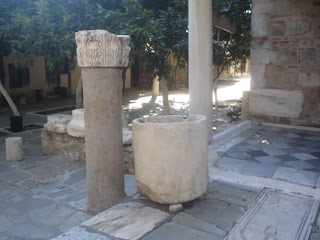Agioi Anargyroi, a single-naved
barrel vaulted church, was built in 1600. No doubt it replaced something
older (some say an 8th century church built by the Empress Irene). Many
renovations have occurred since according to the needs and uses of the
church. They say that the roof shape was
influenced by Ottoman public buildings of the time. It reminds me of Pantanassa
in Monastiraki. In 1972 the Ephorate of Byzantine Antiquities (well,
post-Byzantine in this case – the polite way to refer to the Ottoman era)
renovated the outside of the church to restore its original appearance – and
very attractive it is. The overall masonry consists of small, plain stones
(rubble masonry) accented at the corners by marble or stone blocks, spolia, or
debris from earlier structures. The wall paintings are modern, created in 1858
along with a neoclassical iconostasis, a grand porch, and the bell tower.
The interior
is rather dark but grand and I have never seen so many kandylia in a single
church – so many that they are strung out like the washing on wires running
across the ceiling – gifts of visitors no doubt.
The large
but shallow oval cupola is smaller than the dimensions of the walls and held up,
dome-like, by arches and four triangular concave squinches, each one with a
portrait of one of the evangelists.
Notice the
dragons bowed in submission to the cross on the iconostasis. The subjection of
the old religion was a particularly popular theme from the eighteenth century
and onwards.
Father Dimitrios Kolokynthis founded a monastery with the church as its katholikon in 1651. He had the foresight to leave money for its upkeep
but could not have anticipated the catastrophe of 1687 when the Venetian
campaign against the Turks failed so spectacularly. Agioi. Anargyroi was
severely damaged, the Venetians retreated and so did much of the Athenian
population, no strangers to Turkish reprisals. It remained in a ruinous state
until 1760, when Jerusalem’s Church of the
Holy Sepulchre (Παναγίου Τάφου) purchased it. Their handsome neoclassical Exarchate was built in 1858 and forms the
eastern side of the courtyard. Since then, Agioi Anargyroi has been a dependency ( metochion) of the Jerusalem Church. And therein lies a
tale…
Pilgrimage
Before and
during the Turkish occupation, Athenian citizens made pilgrimages to the Holy Sepulchre in Jerusalem (built on the site
of Christ’s tomb) and returned with burial shrouds - laid aside until the
moment when they could be interred shrouded in greater sanctity. Anyone making
the pilgrimage could add the prefix Hadji to their first name, proof
that they had been to the Holy Land. : Hadji + a first name eventually came
to be a surname and it is still a common surname in Greece. Many pilgrims
bequeathed land and money to the Church of the Holy Sepulchre, enough that the
Jerusalem Patriarch sent an exarch (essentially
a deputy of a patriarch) to Athens to manage their bequests. Agioi Anargyroi
was not the first Jerusalem exarchate in Athens but the subtle irony that its present
headquarters in Athens is the church of ‘the penniless ones’ (lit. those without silver) was probably not noted
at the time. The Jerusalem Exarchate has holdings all over Greece, not just in
Athens.
The Courtyard
The
attractive courtyard makes this one of Athens’ hidden beauty spots. It is full
of trees, dotted with small ancient bits and pieces, with a few Hansel and
Gretel cells on one perimeter and perhaps
the last original Athenian gas lamp still standing. There is also a well with a
reputation. The story goes that this well had a passage communicating with
similar narrow passages in the neighbourhood allowing valuables and even people
to be hidden or transported in times of danger. It is firmly capped now; more’s
the pity.
The exo-narthex
still has its semandron and its mallet although there are no nuns or monks to
call to prayer.
I am still thinking about the waist high hollowed out stone
bowl placed near it in the courtyard, - baptism al fresco perhaps?
Athens has grander churches but at Midnight on Easter Saturday, this is the place to be. As every Orthodox believer knows, at midday on the Saturday after Good Friday, the Patriarch of Jerusalem enters Christ’s crypt alone, holding in his hands 33 candles, one for each year of Christ’s incarnation. And every year the same miracle occurs. The candles are spontaneously lit and the Holy Fire is brought to the surface, transferred to a small lantern and whisked away by Greek police, church officials, and military personnel. It arrives at Athens where it is accorded the honours of a visiting head of state. From there, aircraft take lanterns lit from this one to other cathedrals in Greece, thus spreading the Holy Light throughout the country in time for midnight. It then goes directly via the exarch to Ag Anargyri from which all present will light their candles and say, once again, Christos Anesti: Christ is Risen.








No comments:
Post a Comment